The Cincinnati Bengals joined the AFL in 1968 and were the last expansion team in pro football until 1976. As with all expansion teams, the Bengals struggled in their first season, winning only 3 of their 14 games. The one bright spot was running back Paul Robinson, who gained 1,023 rushing yards, earning him the AFL Offensive Rookie of the Year Award.
The Bengals improved slightly in 1969, finishing the season with a 4–9–1 record. Paul Brown won the AFL Coach of the Year Award, and quarterback Greg Cook received the AFL Offensive Rookie of the Year.
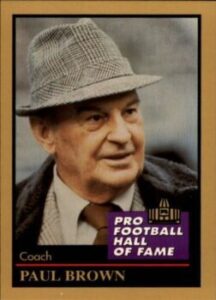
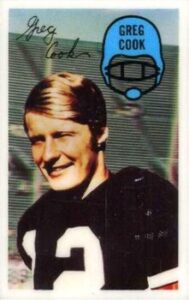
In just their third year in the league, the Bengals ended the season with an 8–6 record and qualified for the playoffs. They lost their playoff game to the eventual Super Bowl Champion Baltimore Colts, but the future looked promising.
Paul Brown was named AFC Coach of the Year for the second consecutive year. After a disappointing 4–10 record in 1971, the Bengals rebounded to 8–6 in 1972 and returned to the playoffs in 1973 with a 10–4 record. They lost that game to the eventual Super Bowl Champion Miami Dolphins.
They dropped to a 7–7 record in 1974 but bounced back in 1975 with an impressive 11–3 record before losing to the Oakland Raiders in the playoffs.
The 68-year-old Paul Brown retired before the 1976 season and was replaced by Bill ‘Tiger’ Johnson, who led the team to a 10–4 record. However, despite this impressive record, Cincinnati failed to qualify for the playoffs.
After a disappointing 8–6 record in 1977, the Bengals began the 1978 season with a 0–5 start, which led to Johnson’s resignation. Homer Rice was named the new coach, but he couldn’t turn the team around, winning only 8 of his 27 games as head coach. Forrest Gregg took over as head coach in 1980, and the Bengals ended the season with a 6–10 record.
LISTEN ON YOUR APP OF CHOICE
1981 Cincinnati Bengals - Unexpected Success
The Bengals kicked off the 1981 season with a 27–21 victory over the Seattle Seahawks, overcoming a 21–0 deficit in the first quarter. Quarterback Ken Anderson struggled and was replaced by third-string quarterback Turk Schonert. The Bengals churned out 210 yards on the ground while yielding only 60 yards rushing to Seattle.
Quarterback Ken Anderson had a strong performance in week two, completing 22 of 34 passes for 252 yards and two touchdowns. Anderson’s primary receiver was Isaac Curtis, who caught five passes for 108 yards. Defensive end Mike St. Clair scored a touchdown on a 12-yard fumble recovery. The Bengals’ 31–30 victory over the Jets improved their record to 2–0.
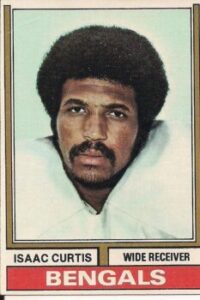
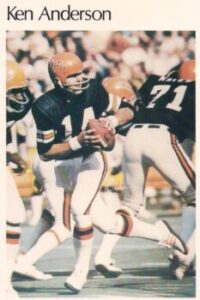
In week three, the Bengals lost 20–17 to the Browns, but the score was deceptive, as the Browns thoroughly dominated the game. The Browns had 31 first downs, while the Bengals managed only 15, and accumulated 185 rushing yards compared to Cincinnati’s mere 48. Total yardage amounted to 422 for Cleveland and 281 for Cincinnati. One bright spot was that Ken Anderson performed well, completing 16 of 25 passes for 238 yards, including a 41-yard touchdown pass to Cris Collinsworth.
A 27-24 overtime victory over the Buffalo Bills in Week Four was an offensive explosion, as Bills quarterback Joe Ferguson threw for 287 yards and three touchdowns. Kenny Anderson threw for 328 yards and three touchdowns. Bengals rookie receiver Cris Collinsworth caught ten passes for 111 yards and one touchdown, while Bills receiver Frank Lewis caught eight passes for 132 yards and two touchdowns. Bengals fullback Pete Johnson rushed for 85 yards on 22 carries.
Dominating the Oilers
In week five, the Bengals outgained the Houston Oilers 357 yards to 187 but still lost the game 17–10. Oilers quarterback Ken Stabler threw only six passes, completing only one for three yards, but the Bengals defense couldn’t stop running back Earl Campbell, who gained 182 yards on 37 carries. Ken Anderson threw for 290 yards, while tight end Dan Ross caught eight passes for 96 yards and scored one touchdown.
The Bengals’ defense held the Colts to 56 yards rushing in week six, but they gave up 336 yards through the air. But all that yardage only added up to two touchdowns. Kenny Anderson had another great game, completing 21 of 27 passes for 257 yards and three touchdowns. Tight end Dan Ross caught seven passes for 106 yards and scored one touchdown. The Bengals breezed to a 41–19 win.
In week seven, the Bengals played a nearly perfect game against the Steelers. Their defense held Pittsburgh to 205 yards total and only ten first downs. Ken Anderson continued his outstanding play, completing 16 of 28 passes for 346 yards and two touchdowns. Backup receiver David Verser scored a touchdown on a 73-yard reception. The Bengals gained 494 total yards en route to a 34–7 win.
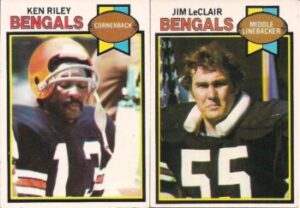
Bengals Felt Too Confident?
Perhaps the Bengals were feeling too good about their impressive win over Pittsburgh because they played poorly the following week against a bad New Orleans Saints team. Their running game was non-existent, gaining just 34 yards, and their passing game wasn’t much better. Ken Anderson threw for 117 yards on 21 attempts before leaving the game with a concussion.
His replacement, Jack Thompson, threw for only 81 yards on 20 attempts. Defensively, the Bengals couldn’t stop workhorse running back George Rogers, who gained 113 yards on 31 carries and scored one touchdown. The final score was New Orleans 17, Cincinnati 7.
In a Week 9 game against the Houston Oilers, the Bengals led 24–7 at halftime. The significant lead effectively neutralized the Oilers’ greatest asset, Earl Campbell. Campbell, who typically had at least 25 carries per game, was restricted to only 14 carries for 74 yards. The Bengals’ defense also intercepted Oilers quarterback Kenny Stabler three times.
Ken Anderson delivered another stellar performance, showing no lingering effects from his concussion the previous week. Anderson completed 21 of 30 passes for 281 yards with three touchdowns. Behind some great blocking by the offensive line, big Pete Johnson rushed for 114 yards on 26 carries and scored a touchdown. The Bengals secured the victory, winning 34–21.
The Bengals traveled to San Diego for a Week 10 matchup against the Chargers. This game would prove to be a true test for the Bengals’ defense, as the Chargers had one of the most explosive offenses in the NFL. The Chargers accumulated significant yardage, totaling 447 yards, but only scored 17 points.
Quarterback Dan Fouts was sacked six times and intercepted twice, including a 102-yard return for a touchdown by defensive back Louis Breeden. The Chargers also fumbled the ball away three times. Kenny Anderson continued to excel, completing 18 of 28 passes for 288 yards and two touchdowns. Chris Collinsworth caught four passes for 97 yards, while Isaac Curtis caught eight for 147 yards and scored one touchdown. The final score was Cincinnati 40, San Diego 17.
In a week eleven game against the LA Rams, the Bengals struggled offensively, gaining only 233 total yards. However, the defense performed well, limiting the Rams to 296 yards and sacking their quarterbacks six times. The Bengals’ defense also forced four turnovers, which the offense capitalized on in this 24–10 victory.
Next for the Bengals was the Denver Broncos. The Bengals’ defense struggled to contain Broncos receiver Steve Watson, who caught five passes for 102 yards and one touchdown. Broncos quarterback Steve DeBerg threw for 305 yards, but he was intercepted twice and sacked four times. The Bengals limited the Broncos to just 68 rushing yards.
The Bengals’ offense had a standout performance. Pete Johnson opened the scoring with a 39-yard touchdown run. Later in the game, running back Charles Alexander added a touchdown with a 65-yard reception. Dan Ross caught seven passes for 123 yards, while Pete Johnson rushed for 99 yards and contributed another 46 receiving yards.
Kenny Anderson, who didn’t have one of his better games against the Rams, reaped rewards in this game. Anderson completed 25 of 37 passes for an impressive 396 yards, with three touchdowns and no interceptions. The Bengals won comfortably, 38–21.
The Bengals’ defense didn’t play well in their week twelve win over the Browns, allowing 349 yards, but they did sack Browns quarterback Brian Sipe five times and recovered three fumbles. Offensively, Ken Anderson had another big day, completing 26 of 32 passes for 235 yards with four touchdowns and zero interceptions.
Behind some excellent blocking, led by tackle Anthony Munoz, Pete Johnson rushed for 105 yards on 21 carries. Johnson also scored two touchdowns and added another 37 yards receiving. Chris Collinsworth gave the Bengals an early 14–0 lead with a 39-yard touchdown reception, and the Bengals never looked back, cruising to an impressive 41–21 victory. It was the team’s fifth win in a row, improving their record to 10–3.


A Letdown and Premonition?
The Bengals were due for a letdown, which came against the 49ers in week fourteen on a cold December day in Cincinnati. The 21–3 score was somewhat misleading. Both teams had 24 first downs; the Bengals totaled 345 yards while the 49ers registered 325.
However, the Bengals turned the ball over six times, and the 49ers capitalized on those mistakes. Ken Anderson left the game with an injury in the third quarter, but honestly, he wasn’t having one of his better days, throwing for only 97 yards with two interceptions.
While the Bengals’ offense wasn’t overpowering in a 17–10 win against the Steelers, they did enough to get the job done. Their defense limited Pittsburgh to only 14 first downs and 207 total yards.
The Bengals traveled to Atlanta for the last game of the regular season. The wind chill was just 11 degrees, but it didn’t hinder Cris Collinsworth, who caught five passes for 128 yards, including a 74-yard touchdown. Running back Archie Griffin scored on an 18-yard touchdown run and the Bengals triumphed 30–28. Their 12–4 record was the best in the AFC, granting them home-field advantage in the playoffs.
Pete Johnson, Cris Collinsworth, Anthony Munoz, and Ken Anderson were selected for the Pro Bowl. Munoz also earned a spot on the All-Pro team, as did Anderson, who received the prestigious award of the 1981 NFL MVP.
1981 NFL Playoffs
Their first opponent was the Buffalo Bills, whom the Bengals had defeated in Week four. However, it took a field goal in overtime to clinch the victory. The playoff game was similarly intense, as the Bills once more challenged Cincinnati fiercely.
The Buffalo defense sacked Kenny Anderson four times, yet he finished the game with a passer rating of 111.6. With the score tied at 21 in the fourth quarter, Anderson connected with Collinsworth for a 16-yard touchdown, securing the game at 28–21.
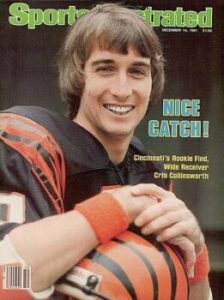
1981 AFC Championship Game
The Bengals were one win away from their first AFC title in team history. Their opponent was the San Diego Chargers, whom the Bengals had easily defeated in week ten. However, the Chargers were on fire, winning five of their last six games, including a 41–38 playoff victory in double overtime against the Dolphins. Yet the Bengals had the perfect weapon to cool down the Chargers: the weather.
The game-time temperature was minus 9 degrees with a wind chill factor of minus 32. The Bengals’ defense contained the high-powered San Diego passing game to 185 yards and forced four turnovers by the Chargers. Ken Anderson completed 14 of 22 passes for 161 yards and two touchdowns with no interceptions. Pete Johnson added 80 rushing yards, and the Bengals emerged victorious with a score of 27–7.
Super Bowl XVI - Bengals vs. 49ers
The Bengals were the 1981 AFC Champions and would play the SF 49ers in Super Bowl XVI. The game took place in Detroit, where the wind chill was 25 degrees below zero. The extreme temperature made traveling hazardous, as the roads were a sheet of ice. However, the weather wouldn’t impact the game since it was played in a domed stadium.
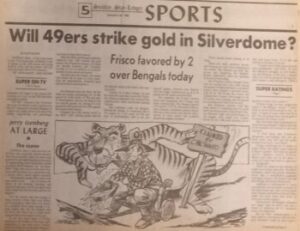
The Bengals caught a break immediately when the 49ers fumbled the opening kickoff. But San Fran quickly regained possession with an interception, then drove 68 yards down the field to take a 7–0 lead.
In the second quarter, Ken Anderson connected with Cris Collinsworth on the 49ers’ 8-yard line, but Collinsworth fumbled, and San Fran recovered. The 49ers marched 92 yards for their second touchdown and added a field goal to make it 17–0. Right before halftime, the Bengals fumbled a squib kick, allowing the 49ers to add another field goal. In the first half, the Bengals squandered two scoring opportunities and turned the ball over three times.
Cincinnati opened the third quarter with an 83-yard drive, narrowing the gap to 20–7. The touchdown energized the Cincinnati defense, which held the 49ers to just 4 yards in the third quarter. Late in the quarter, Ken Anderson connected with Cris Collinsworth for a 49-yard gain, placing the ball at the 49ers’ 16-yard line.
A few plays later, they found themselves on the three-yard line with a first down and goal to go. A two-yard run brought them to the 1-yard line. The next two plays resulted in no gain, and the Bengals opted to go for it on fourth down. They didn’t succeed, and the 49ers took possession. However, the Bengals’ defense forced a stop and gave their offense another opportunity. The Bengals then scored on a 53-yard drive, bringing the score to 20–14.
With ten minutes remaining in the game, the 49ers managed to run down the clock and got into field goal range, extending their lead to 23–14. A second interception by the 49ers positioned them for another field goal, making it 26–14. With only two minutes left, the Bengals needed a quick touchdown to have any hope of winning.
They scored the touchdown, but it consumed almost the entire two minutes. With 16 seconds remaining, the Bengals lined up for an onside kick, but San Francisco recovered it, ending the season in disappointment.
Despite throwing two interceptions, Ken Anderson played well, completing 25 of 34 passes for 300 yards and two touchdowns. Tight end Dan Ross caught 11 passes for 104 yards and scored two touchdowns. The Bengals outgained the 49ers 356 yards to 275, but four turnovers and several missed scoring opportunities ultimately cost them. However, despite the loss, the Bengals accomplished more than anyone could have imagined at the start of the season.
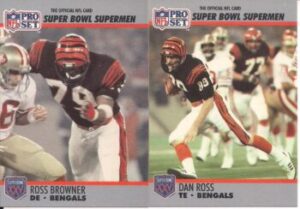
Seven years later, the two teams met again in the Super Bowl, and the Bengals lost another close game, 20–16. Cincinnati captured its third AFC title in 2021 but fell short once more in the Super Bowl, losing to the Rams 23–20.
Mark Morthier is the host of Yesterday’s Sports, a podcast dedicated to reliving memorable sports moments from his childhood days and beyond. He grew up in New Jersey just across from New York City, so many of his episodes revolve around the great sport’s teams of the 70s for the New York area.
He is also an author of No Nonsense, Old School Weight Training (Second Edition): A Guide for People with Limited Time and Running Wild: (Growing Up in the 1970s)

BOOKS BY MARK MORTHIER
Please Note – As an Amazon Associate I earn from qualifying purchases
More From Yesterday's Sports
Muhammad Ali’s Chin: Knocked Down Only 4 Times
Muhammad Ali’s boxing career is well documented, so instead of...
Read MoreLarry Brown – Is He Hall of Fame Worthy?
A committee member recently asked me my opinion on inducting...
Read More1970s Minnesota Vikings : Would A Better QB Helped Them Win A Super Bowl?
Here’s a question I often hear, especially from Minnesota Vikings...
Read More1975 Baltimore Colts: A Year In Review
From 1957 to 1971, the Baltimore Colts never experienced a...
Read More


